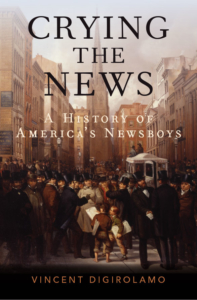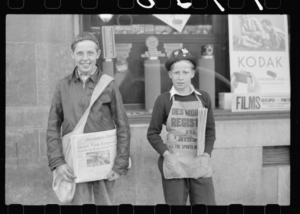
Iowa Newsboys
John Vachon Source
Photo Credit: Farm Security Administration
Despite many warning signs, the stock market crash of 1929 took the nation by surprise. One Oklahoma teenager was so baffled when he heard newsboys shouting “Extra! Extra! Stock Market Collapses” that he thought it referred to a disaster at a cattle auction barn. The boys who cried the headlines knew better, and cashed in on the panic. Nine-year-old Dempsey Travis hustled the Chicago Defender right up to October 24, Black Thursday, but then sales plunged. “Before the year’s end,” he said, “my customers were more concerned about feeding their stomachs than feeding their minds.”
Few people were left untouched by the falling economy, and certainly not America’s newsboys. If it didn’t drive them from the trade, it stretched out their news careers longer than most would have liked. The proportion of newsboys between 16 and 19 years old rose during the decade, according to the US Census, and they had to contend with an influx of adults into their ranks.
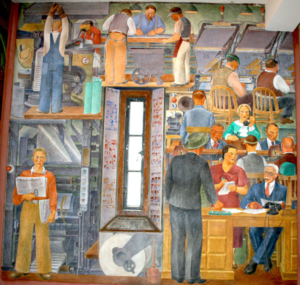
Mural, Newsgathering
New Deal murals portrayed newsboys’ labor as integral to their industry. Detail, Suzanne Scheuer and Hebe Daum, Newsgathering, Coit Tower, San Francisco. Public Works of Art Project, 1934.
Photo Credit: Diderot Creative Commons
In Detroit, automobile production ground to a halt and half the adult population lost their jobs. City officials converted factories into homeless shelters and issued the unemployed licenses to sell apples in lieu of relief. Four thousand hungry schoolchildren stood daily in bread lines while seventeen thousand worked the streets, almost half of whom either sold or delivered newspapers.
With so much competition, one newsboy gang formed a “vengeance squad” to protect its turf. In December 1931, four of the boys went looking for 15-year-old Joe Przystas for beating up a pal. They found him at home carrying a scuttle of coal upstairs. One of the boys pulled a rifle from his pant leg and fired at the scuttle to frighten Przystas but drilled him in the heart instead. The killing drew national attention as symptomatic of the moral breakdown accompanying the city’s economic collapse.
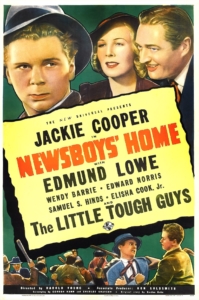
Movie Poster, "Rifle"
Proletarian newsboy heroes abounded in the popular culture of the depression era. Here Jackie Cooper stars as “Rifle” Edwards in Universal Studio’s Newsboys’ Home, 1938. Author’s collection.
The most devastating financial crisis in American history, the Great Depression exposed newsboys to the vicissitudes of the market and the power of the state in unprecedented ways. The crisis sparked renewed debate at the highest levels of government about the social costs of child street labor. Newsboys came under federal protection for the first time with the passage of New Deal legislation, but publishers resisted such “meddling” as threats to press freedom. Rising discontent and a surging labor movement led newsies to mount strikes and support those of longshoremen, truck drivers, projectionists and other workers.
Caught up in this tug-of-war between a paternalistic capitalist press and an expansive welfare state, the newsboy became a contested figure in popular culture, appearing in plays, comics, movies, murals, photographs and fiction as a symbol of working-class resentment more often than as an icon of bourgeois virtue. He was the shrill, restless son of Franklin Roosevelt’s proverbial “forgotten man at the bottom of the economic pyramid,” and in this capacity helped America reassess the merits of laissez-faire capitalism and recalibrate government’s responsibility to citizens young and old.
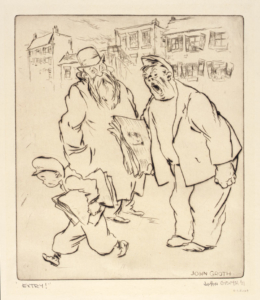
'Extry,' John Groth
Chicago artist John Groth noticed the influx of adults into the ranks of news hawkers in 1931 when he sketched this burly vendor bellowing a tiny rival off the street. John Groth, Extry,
Photo Credit: Courtesy of the Smithsonian American Art Museum, Gift of Chicago Society of Etchers. 1935.13.129.
